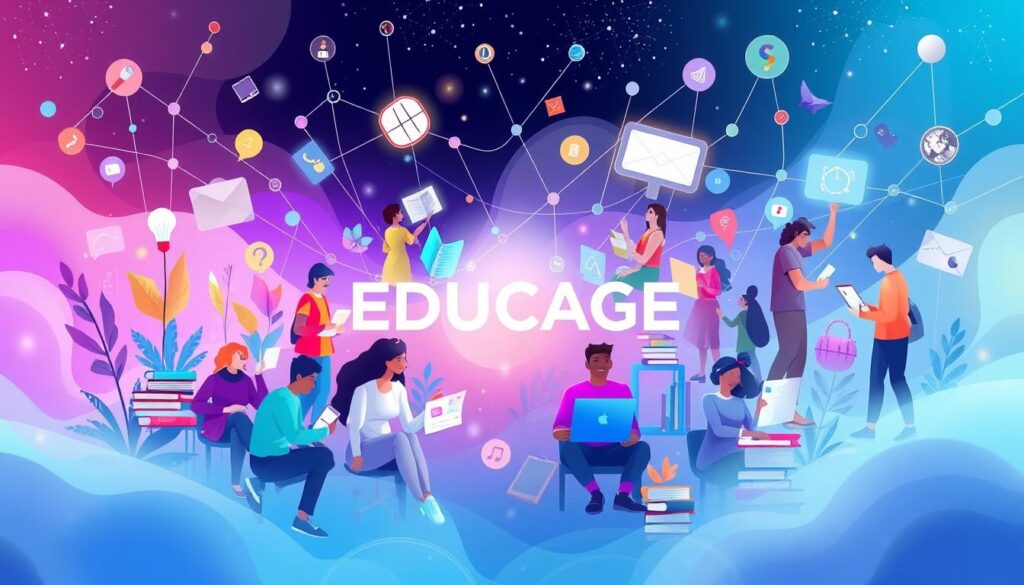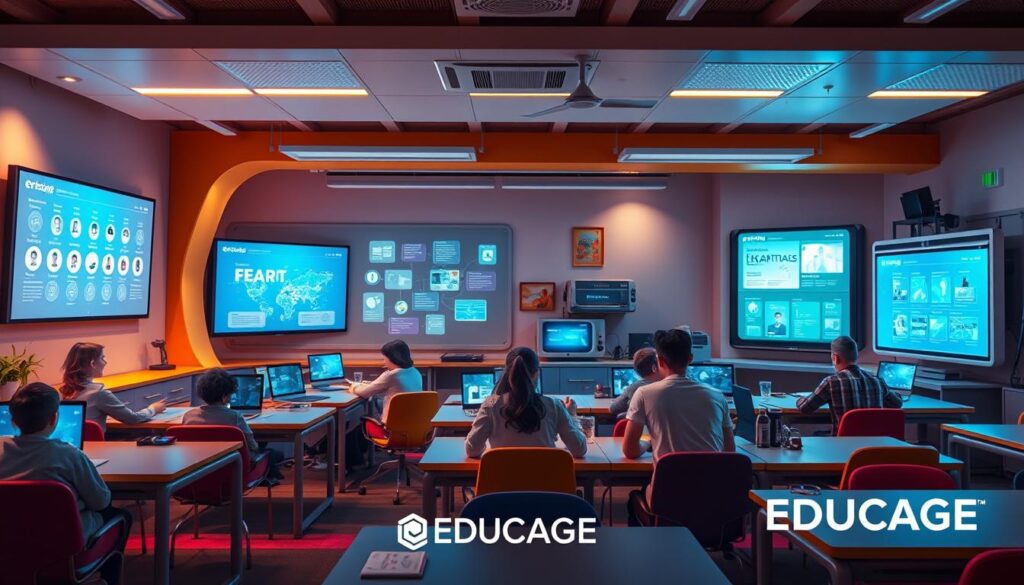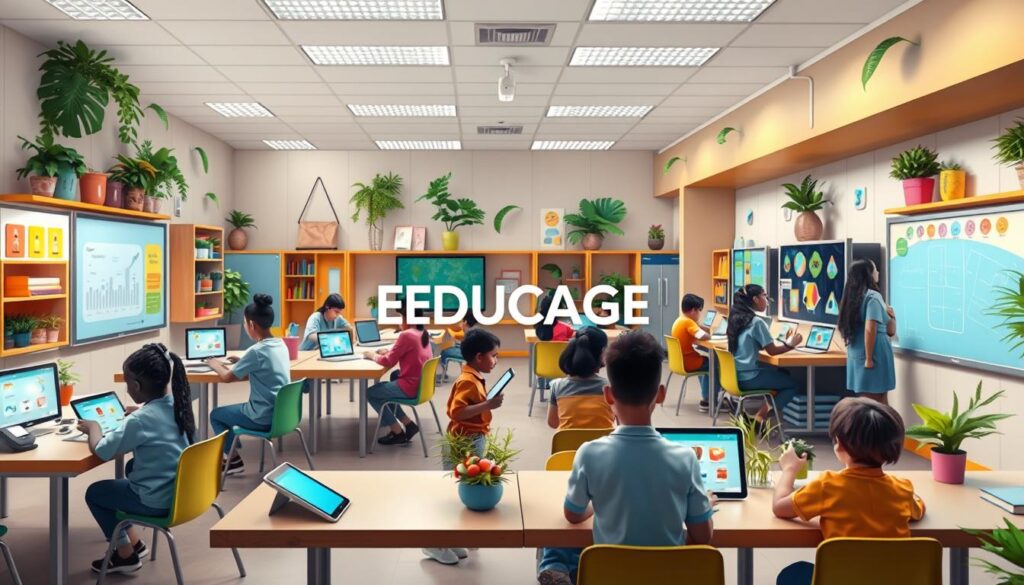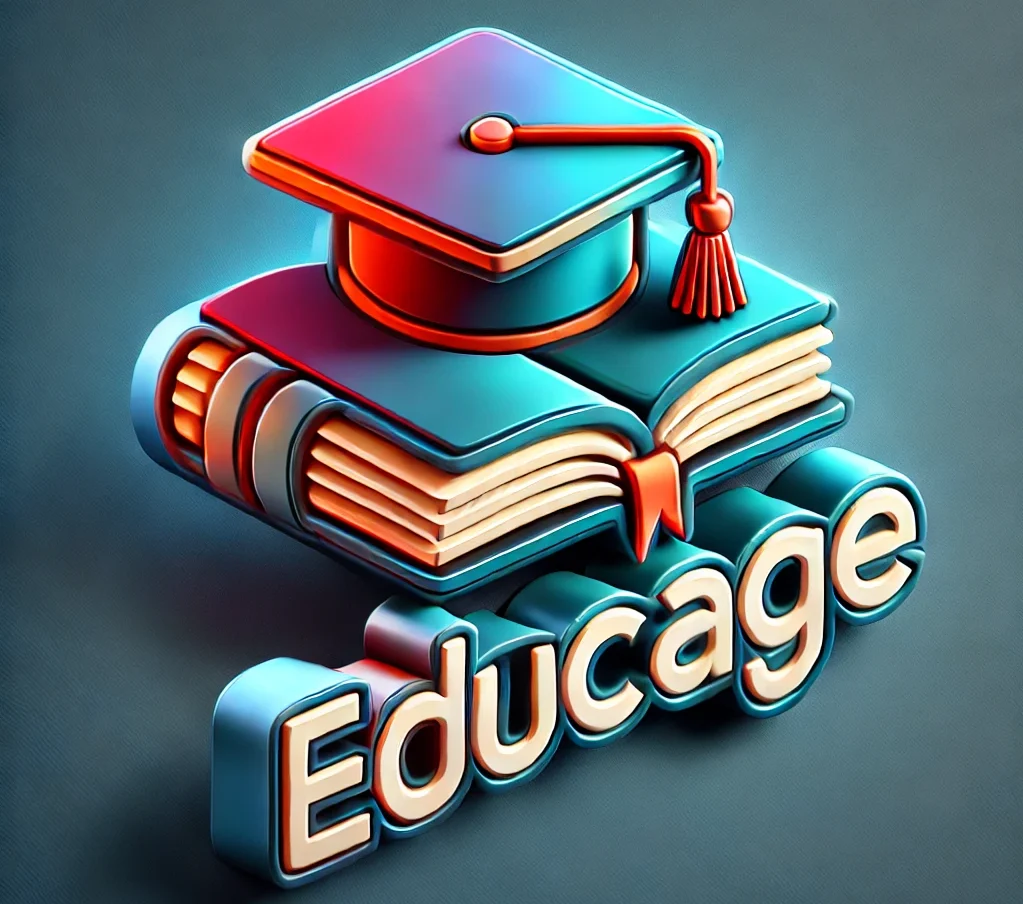Have you ever thought about if your peers could teach you better than teachers? Peer-to-Peer Learning Platforms are sparking a big debate. They ask if these online platforms can replace traditional classrooms. With over 6 million students taking online courses before COVID-19, it’s interesting to think if tech can offer a better learning space than old-school methods.
Let’s dive into how education might change. Studies show online learning can be just as good, or even better, than in-person classes1. Today, 84% of online bachelor’s degree holders are already working, showing that online learning fits well with life’s demands1. Plus, online degrees are way cheaper, averaging $60,593 from a private school, compared to $185,252 for in-person learning1.
Key Takeaways
- Online education platforms are increasingly popular, with millions of students enrolled.
- Research indicates that online students may perform better than those in traditional classrooms.
- Cost-effective learning options are available, making education more accessible.
- Peer learning fosters collaboration and community among students.
- Flexibility in learning allows students to balance studies with life commitments.
Introduction to the Evolution of Education
The evolution of education has seen big changes over the years, especially with educational technology. Traditional schools were once the main place for learning. But now, online learning is becoming more popular, especially with global events. Digital platforms have made it easier for students to work together, leading to better understanding.
Peer learning has become a key part of this change. Teachers use methods like Jigsaw and Problem-Based Learning to help students learn from each other. This approach has shown to improve learning results. Studies in sociology and instructional design have shown its effectiveness23.
Looking at the evolution of education, we see old methods blending with new tech. This shift towards flexible learning shows that online learning is now a good option. Better communication and teamwork among students make learning more engaging and effective. These changes help students get ready for the future and take charge of their learning.
The Rise of Peer-to-Peer Learning Platforms
Peer-to-peer learning is changing education. It lets people learn together through websites and platforms led by students. This way, everyone can share what they know, making learning a team effort.
Digital communities around these platforms make learning easier to get to. They make education more personal and helpful for everyone.
Defining Peer-to-Peer Learning
Peer-to-peer learning is about students helping each other. It uses online tutoring to teach important skills like talking and leading. As these networks grow, more people can learn together, reaching their full potential.
Check out this link to see how online education is growing.
Growth and Popularity of Peer-to-Peer Platforms
More and more people are using peer-to-peer learning platforms. They are seeing better results in learning and more people are taking part in online classes4. These tools are great for adults who have a lot on their plates, making them very popular4.
Seventy-nine percent of CEOs worry that skill gaps could hurt their business. This shows how important good learning places are5. These digital tools are making a big difference in teaching real-world skills6.

Advantages of Peer-to-Peer Learning Platforms
Peer-to-peer learning platforms are changing education in big ways. They offer flexibility and accessibility that traditional schools can’t match. This is especially helpful for students with busy lives, as they can learn at their own pace.
These platforms let you fit your studies into your schedule. This flexibility is a big plus compared to traditional classrooms. It’s great for those with work or family commitments.
Flexibility and Accessibility
Getting an education is more important than ever. Peer-to-peer learning platforms break down barriers, making education available worldwide. You can access valuable resources and learn from peers globally.
This global reach makes learning richer and builds a strong online learning community. Studies show these platforms are growing. They help students collaborate and share ideas, making education more inclusive7.
Cost-Effectiveness Compared to Traditional Schools
Peer-to-peer learning is also very affordable. It cuts down on costs like commuting and materials. This makes education more affordable online.
For students from low-income backgrounds, this is a big deal. Over 800 distance learning systems exist worldwide. This shows a trend towards affordable, individualized education8. Plus, new technologies offer learning experiences tailored to your goals, changing education forever.
| Platform Name | Best For | Trial Period | Pricing Notes |
|---|---|---|---|
| EducateMe | Collaboration | 2 weeks | Flexible pricing available upon inquiry |
| Schoox | Employee Training | N/A | Flexible pricing provided upon inquiry |
| Blackboard | Social Learning | N/A | Pricing upon inquiry |
| Peerceptiv | Classroom Collaboration | N/A | Pricing upon filling out contact form |
| PeerStudio | Higher Education | N/A | Free of charge |
In summary, peer-to-peer learning platforms offer flexibility, accessibility, and affordability. They are changing education for the better. As they grow, they promise to make learning more accessible and inclusive for all78.
Challenges Faced by Peer-to-Peer Learning Platforms
Peer-to-peer learning platforms offer many benefits but face big challenges. One major issue is the lack of in-person interaction. Without face-to-face talks, learners struggle to develop social skills and emotional intelligence. These are key for a well-rounded education.
Lack of In-Person Interaction
Face-to-face talks are vital for emotional development in learning. Young learners especially need direct communication and engagement. Studies show that peer-to-peer learning challenges like group dynamics must be managed well for success.
Customer Support and Quality Assurance
Another big challenge is customer support in online platforms and ensuring quality assurance in education. Unlike traditional schools, peer-to-peer platforms often lack dedicated support staff. This can make learners feel unsupported, hurting their educational journey.
Quality issues due to peer knowledge and lack of feedback mechanisms are also problems. Time constraints and the sensitivity of giving feedback make these issues harder to solve9. It’s important to monitor peer-to-peer programs closely and set clear expectations from the start1011.

| Challenges | Description | Impact on Learning |
|---|---|---|
| Lack of In-Person Interaction | Reduces opportunities for social skills development | Hinders emotional intelligence growth |
| Customer Support Limitations | Insufficient assistance for learners | Leaves learners feeling unsupported |
| Quality Assurance Concerns | Inconsistent learning outcomes | Affects overall educational experience |
By tackling these challenges, peer-to-peer learning platforms can improve. They can offer a stronger educational framework10911.
Traditional Classrooms: Benefits and Drawbacks
Traditional classrooms are key in education, offering a structured setting that aids students’ learning. One big plus is the personal interaction. This interaction lets teachers give immediate feedback, helping them meet each student’s needs. For centuries, traditional learning has evolved, adapting to new technologies and societal shifts12.
Immediate Feedback and Personal Interaction
Students in traditional classrooms do better than those online. They get to ask questions and get answers right away, which helps them understand better13. Teachers can also see how students are doing, helping to solve problems quickly. Traditional classrooms also help students remember things better, thanks to discussions and teamwork13.
Structured Learning Environment
Students in traditional classrooms learn in a well-organized way. This helps them develop discipline and manage their time. They get to do hands-on activities and talk in groups, improving their thinking and problem-solving skills. Plus, they learn social skills through face-to-face activities12.
Studies show that this kind of education lowers stress and anxiety. It helps students feel more positive and happy12.
Peer-to-Peer Learning Platforms vs. Traditional Classrooms
Exploring modern education, it’s key to know the differences between peer-to-peer learning and traditional classrooms. The learning outcomes in education from these models show unique benefits and challenges. Online education offers flexibility but may not retain information as well as traditional classrooms do.
Traditional classrooms excel in making human connections. This leads to better academic performance and deeper emotional engagement with the material1415.
Comparing Learning Outcomes and Effectiveness
Online education’s effectiveness depends on individual learning styles and resources. Online platforms let learners move at their own pace. But, some students may miss the structure of traditional classrooms, where in-person guidance boosts performance1415.
Online courses offer a wide range of subjects. However, they often lack the hands-on experiences needed for subjects like science or performing arts. Traditional classrooms provide essential peer interaction, fostering a sense of belonging and community.
Social and Emotional Development Opportunities
Traditional classrooms are great for developing social skills through structured interactions and extracurricular activities. These activities enhance teamwork and leadership abilities. They help students build strong community ties, crucial for personal and professional growth15.
Peer-to-peer learning can offer similar interactions but lacks the consistency of face-to-face engagements. When choosing between these models, think about how they align with your personal or academic goals. Both social and emotional aspects are vital to your learning experience.

The Role of Educational Technology in Learning
Educational technology is changing how we learn today. It brings digital tools into classrooms and online learning spaces. These tools help students engage more with their studies. They make learning fun and interactive.
Integrating Digital Tools in Education
Classrooms today can greatly benefit from technology. Tools like GoGuardian Admin keep students safe by filtering web content. This ensures they stay focused on the right materials16.
Apps that let students annotate texts together spark conversations and critical thinking. This helps them understand better17. Google Docs, for example, helps students work together. It boosts their teamwork skills and academic success16.
Impact on Student Engagement
Digital solutions have a big positive effect on students. They help students learn to self-regulate and improve their communication skills. These skills are key for their education17.
Interactive tools also boost students’ grades and prepare them for their careers16. Technology makes learning more fun and personal. It strengthens the bond between students and teachers, making education more enjoyable.
| Type of Digital Tool | Benefits | Examples |
|---|---|---|
| Social Annotation Tools | Fosters discussion and critical thinking | Hypothesis, Diigo |
| Collaborative Platforms | Enhances teamwork and communication skills | Google Docs, Microsoft Teams |
| Classroom Management Software | Monitors student activity and engagement | GoGuardian, ClassDojo |
| Interactive Learning Tools | Improves academic performance and participation | Kahoot!, Quizlet |
In conclusion, using educational technology and interactive tools can really improve learning. It boosts student engagement and results1716.
Collaboration through Peer Mentorship and Virtual Study Groups
Learning together makes school better. Peer mentorship helps students connect. Virtual study groups make learning fun and productive. These methods help you understand and remember more, and you won’t feel alone.
Building a Collaborative Learning Environment
Peer mentorship fights loneliness and boosts happiness18. Mentors give confidence and motivation for school and life goals18. They also teach leadership and communication, helping beyond school18. This support makes learning better, leading to better grades18.
Virtual study groups add to the teamwork. They make learning stick better, as students think and solve problems together18. This teamwork reduces stress and builds friendships18.
Success Stories from Peer Learners
Many students have great stories about learning together. They feel better because they support each other18. Tools like video calls and interactive boards make learning sessions better18. Scheduling tools help everyone meet up on time, making learning more effective18.

Case Studies: Successful Peer-to-Peer Learning Platforms
Peer-to-peer learning platforms have become key in education. They show how learning can be improved through sharing knowledge. Companies like Siemens and Google have used these methods to help employees grow during tough times. This has led to online learning platforms that meet many needs.
The case studies in education show how these platforms handle new challenges. They also build a community of learners who are engaged and eager to learn.
Examples of Effective Platforms Globally
Many platforms stand out for their peer-to-peer learning. Kialo Edu is one, offering tools that make discussions and projects better. It uses methods like think-pair-share and Socratic seminars to keep students involved19.
Companies use peer-to-peer training to overcome learning hurdles. This approach creates a space where people can talk and think critically20.
Lessons Learned from Peer-to-Peer Initiatives
Peer learning offers valuable lessons for education. It’s important to make learning places where everyone feels safe to share19. Regular feedback from peers helps students learn to evaluate and improve work19.
Peer-to-peer learning also saves money, making it a smart choice for schools and companies20. The focus is on teaching skills like managing time, projects, and communication.
Future Trends in Education: The Blend of Learning Approaches
The future of education is all about blending old and new ways of learning. This mix of traditional teaching and modern online learning creates a space for all kinds of learners. Knowing what makes up this blend is key to great learning.
The Importance of a Hybrid Model
Hybrid learning combines the best of classroom and online learning. It makes learning fun and interactive, boosting student motivation. By 2050, almost everyone will have internet access, opening up learning to billions21.
AI helps make learning fit each student’s needs, making it more effective22. The use of games in learning is also growing, expected to hit USD 29.7 billion by 202621.
Potential Innovations in Education Technology
New tech in education is changing how we learn. Tools like analytics in e-learning help track progress and improve learning22. Microlearning breaks down big topics into easy-to-remember chunks, boosting retention22.
Virtual and augmented reality bring learning to life, making it more engaging23. As schools use these tools, learning becomes more tailored to each student, marking a big shift in education.

Exploring new tech in learning opens up endless possibilities for both teachers and students212223.
Access and Equity in Education: A Pressing Concern
Education is a basic right, but the digital divide in education limits many students. Without access to online education, students from different backgrounds face big challenges. Low-income families often can’t afford private schools, showing the need for inclusive education solutions.
Schools in poor areas often lack textbooks and technology. This makes learning harder for students there. The quality of education varies greatly, affecting students’ success chances24.
Addressing Digital Divide Issues
To solve the digital divide in education, we need strategies for equitable learning opportunities. We should improve technology and internet access for those who need it most. Schools should work with community groups to find and fix barriers to learning.
During the shift to online learning, talking with students and families is key. This helps find out what challenges diverse learners face25. By listening to families and students, schools can build trust and support for everyone’s needs.
Ensuring Inclusive Learning Opportunities
Our goal is to make sure all students can succeed. We need to train teachers to understand their students’ backgrounds26. Teaching that includes social justice and community issues can really help students feel involved.
By letting students reflect on their own learning, we help them share their needs. This way, teachers can give support that fits each student’s needs25. Working together, we can remove barriers and make education fair for all.
| Barriers to Access | Impact on Learning | Proposed Solutions |
|---|---|---|
| Limited Technology Access | Hinders participation in online education | Increase funding for device and internet access |
| Financial Constraints | Prevents enrollment in quality private schools | Implement scholarship programs for low-income families |
| Inequitable Resource Distribution | Creates disparities in educational quality | Ensure equitable funding for all school districts |
| Cultural Disconnect | Reduces student engagement and trust | Use culturally responsive teaching practices |
Personalized Learning Experiences in Peer Learning Platforms
Personalized education in peer learning platforms changes how we learn. It uses adaptive learning technologies to tailor experiences for each learner. This makes learning more engaging and effective.
Adapting to Individual Learning Styles
Learning styles customization is key to better education. Personalized learning works through teamwork, fitting each learner’s needs. For instance, modular content lets learners pace themselves, leading to better understanding.
Studies show adaptive learning boosts student scores by up to 23%27. AI-generated content also raises engagement by 35%27.
Enhancing Learning Through Customization
Customized learning experiences focus on the student. Teachers can create plans based on each student’s abilities. This ensures learning is optimized.
Cloud-based platforms help analyze student performance. They provide personalized feedback and support28. This approach boosts motivation and assignment scores by up to 45%27.
Personalized education helps learners reach their goals. High-performing organizations value it, with 93% recognizing its benefits29.

The Importance of Community in Learning
Creating a strong community in education greatly affects students’ learning. Peer-to-peer relationships help build supportive connections. These connections are key for teamwork among students. A community makes learning more dynamic, as students work together and learn from each other.
Fostering Relationships Between Learners
Building relationships in a learning community makes students feel part of something. Studies show that 68% of online classes with a focus on community building see better grades and student satisfaction30. This setting also helps students talk and think critically, which is good for their minds31. It helps them understand each other better, improving both school and social skills32.
Impact on Knowledge Retention
Being part of a community helps students remember what they learn. Sharing knowledge together makes students better at recalling information30. This teamwork leads to a deeper understanding and better memory, showing that students do best in supportive places32. These communities are key to students’ success and happiness in school31.
| Community Building Benefits | Academic Outcomes | Emotional Wellbeing |
|---|---|---|
| Improved Dialogue and Reflection | Higher Retention Rates | Increased Self-Esteem |
| Supportive Peer Relationships | Enhanced Critical Thinking | Better Social Skills |
| Active Participation | Increased Student Engagement | Greater Academic Satisfaction |
In short, a strong community in education is vital for students’ success and growth. It makes learning better through teamwork and understanding each other.
Exploring Collaborative Learning Tools and Resources
In today’s changing education world, using collaborative learning tools is key. These tools help students connect with each other and offer great resources for learning online. They make learning more fun and effective.
Tools That Facilitate Peer Connection
Many tools are made to help students work together better. For example, Moodle and Canvas have features like group work and peer reviews. These help students work on projects together.
Video tools like Zoom and Microsoft Teams make it easy to talk face-to-face. This is great for working together on projects. Also, sites like Edmodo and Reddit let students create communities to share and work on projects together33.
Interactive Study Technologies
Interactive tools make learning more exciting. Google Jamboard and Microsoft Whiteboard let students work together in real time. This helps them understand subjects like science and social studies better33.
iSpring Learn has affordable plans starting at $2.29 per user per month. This makes it easy for many to use34. ELB Learning focuses on content made by users and offers short learning modules for different needs34. These tools help create a lively learning space.

Using these tools helps students work together and learn in different ways. Yet, only a small number of places use peer training. This shows a need for more to use these new ways to engage35. Tools like Google Docs let students edit documents together. They get feedback right away, which helps them learn better33.
When you look into these tools, think about how they can make learning better. The right tools can make learning fun and help students understand things deeply.
Evaluating the Impact of Peer-to-Peer Learning Platforms
Peer-to-peer learning platforms are changing how we learn online. Studies show they can lead to different results than traditional classrooms. For example, students who learn together see a 1.7 mark increase on tests36.
This shows how well these platforms work in boosting grades. It’s mainly because of the help from teachers and how students interact with each other.
Academic Performance Comparisons
Many students like learning with their peers. In fact, 90% of them say teachers make sessions more interesting36. This shows that good teaching can really help students do better.
Platforms that help students think and solve problems together also improve results. This matches the goals of good peer learning and tracking social skills in school.
Social Skills Development Tracking
Tracking social skills in learning shows how students work together. Skills like talking and teamwork grow from group work and projects. This is key to peer learning platforms.
Building friendships and support groups help students learn these skills. Programs that focus on setting goals and giving feedback also help37. Learning in these ways not only helps with school but also with social skills for life.
The impact of peer learning is clear. It’s important to see how these platforms improve both school grades and social skills.
Conclusion
The way we learn is changing, moving towards more peer-to-peer learning. This shift includes using platforms like Swollet to improve how we work together. Studies show that this approach helps students remember more and think critically38.
It also makes learning more fun and engaging39. This is because working with peers boosts motivation.
But, there are challenges like the spread of wrong information and differences in knowledge levels39. To overcome these, combining peer learning with traditional methods is key. This mix offers a well-rounded learning experience, preparing you for the real world and building a supportive community40.
In the end, blending peer learning with traditional classrooms enriches our education. It not only boosts our grades but also teaches us valuable life skills. These skills will be crucial for your future.
FAQ
What are peer-to-peer learning platforms?
How did online education grow before the COVID-19 pandemic?
What are the advantages of peer-to-peer learning platforms?
What challenges do peer-to-peer learning platforms face?
How do traditional classrooms benefit students?
Are learning outcomes different in peer-to-peer platforms compared to traditional classrooms?
What role does educational technology play in learning?
How can students build a collaborative learning environment?
What are some successful peer-to-peer learning platforms?
What innovations can impact the future of education technology?
How can we ensure equitable access to education?
What is the importance of community in learning environments?
How can interactive study technologies enrich the learning experience?
How is academic performance measured in peer-to-peer learning platforms?
Source Links
- https://unity.edu/articles/online-vs-in-person-classes/
- http://hilt.harvard.edu/wp-content/uploads/2019/10/HILT-2019-HANDOUT-FORMATTED-4-PP.pdf
- https://www.effectiveinstitutions.org/files/The_EIP_P_to_P_Learning_Guide.pdf
- https://sertifier.com/blog/the-power-of-peer-to-peer-learning-in-the-digital-age/
- https://www.togetherplatform.com/blog/peer-learning-benefits
- https://www.linkedin.com/pulse/rise-collaborative-learning-how-peer-networks-skill-growth-tavares-zsp5f
- https://uniathena.com/peer-to-peer-learning-platforms
- https://www.educate-me.co/blog/best-peer-to-peer-learning-platforms
- https://mylearninghub.com/blog/post/p2p-learning-and-power-mentorship
- https://www.linkedin.com/advice/0/what-benefits-challenges-peer-to-peer
- https://educationalist.substack.com/p/on-fostering-peer-to-peer-learning
- https://funderstanding.com/learning/theory/the-benefits-of-traditional-learning/
- https://www.eschoolnews.com/innovative-teaching/2024/04/05/online-learning-vs-classroom-learning-research/
- https://elearning.company/blog/online-learning-an-effective-alternative-to-traditional-classrooms/
- https://www.continents.us/can-online-learning-replace-traditional-schools-why-why-not/
- https://www.goguardian.com/blog/technology-in-the-classroom-importance-challenges
- https://www.linkedin.com/advice/3/what-some-innovative-ways-use-peer-to-peer
- https://www.quadc.io/blog/peer-mentoring-and-study-groups-the-secret-to-student-success
- https://blog.kialo-edu.com/teaching-strategies/reaping-the-benefits-of-peer-to-peer-learning-strategies/
- https://engageforsuccess.org/learning-and-development/peer-to-peer-learning-to-boost-work-performance/
- https://www.educate-me.co/blog/future-of-education-technology
- https://devskiller.com/blog/learning-and-development-trends/
- https://www.linkedin.com/pulse/future-online-learning-trends-innovations-higher-daniel-nieto-m-s–yhshc
- https://www.graygroupintl.com/blog/access-to-education
- https://ies.ed.gov/ncee/edlabs/regions/pacific/blogs/blog27_culturally-responsive-leading-and-learning_addressing-equity.asp
- https://ascd.org/el/articles/creating-clarity-on-equity-in-schools
- https://www.restack.io/p/peer-to-peer-tech-learning-initiatives-answer-ai-learning-platforms
- https://itopia.com/enhancing-personalized-education-with-cloud-based-learning-platforms/
- https://www.intellum.com/resources/blog/personalized-learning
- https://www.educate-me.co/blog/how-to-build-an-online-learning-community
- https://ctl.columbia.edu/resources-and-technology/teaching-with-technology/teaching-online/community-building/
- https://www.educause.edu/research-and-publications/books/learning-spaces/chapter-4-community-hidden-context-learning
- https://arch-te.com/collaborative-learning-using-technology-to-foster-teamwork-communication/
- https://elearningindustry.com/top-social-collaborative-learning-platforms
- https://disprz.ai/blog/mastering-collaborative-learning-at-workplace
- https://pmc.ncbi.nlm.nih.gov/articles/PMC10736198/
- https://www.linkedin.com/pulse/power-peer-to-peer-learning-communities-challenge-university-4ymxf
- https://www.linkedin.com/pulse/power-peer-2-peer-learning-online-education-swollet
- https://saima.ai/blog/what-is-peer-learning
- https://blog.degreed.com/the-power-of-peer-to-peer-learning-safe-spaces-valuable-skills/
